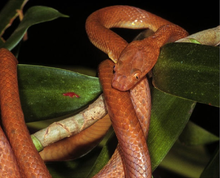| Lycodryas | |
|---|---|

| |
| Lycodryas maculatus | |
| Scientific classification | |
| Domain: | Eukaryota |
| Kingdom: | Animalia |
| Phylum: | Chordata |
| Class: | Reptilia |
| Order: | Squamata |
| Suborder: | Serpentes |
| Family: | Pseudoxyrhophiidae |
| Subfamily: | Pseudoxyrhophiinae |
| Genus: | Lycodryas Günther, 1879 |
| Type species | |
| Lycodryas sanctijohannis Günther, 1879
| |
| Species | |
|
9 recognized species, see text | |
| Synonyms[1] | |
|
Stenophis Boulenger, 1896 | |
Lycodryas is a genus of snakes in the family Pseudoxyrhophiidae. The genus contains nine species, seven of which are endemic to the island of Madagascar, and two to the Comoros Islands.[2] Its sister taxon is Phisalixella.[1] All of the species are harmless to humans.
Ecology
[edit]Lycodryas are arboreal snakes that are believed to be active hunters. However, their ecology is generally poorly known.[1]


Description
[edit]Lycodryas are markedly elongated, slender-bodied snakes with often striking coloration. The head is distinct. They typically have 8 (range: 7–9) upper labials and 6–10 lower labials, 1 loreal scale, 17–19 rows of dorsal scales at mid-body and 13 or 15 rows of dorsal scales at the last ventral, 185–284 ventral scales, anal plate that is usually divided, and 70–130 subcaudal scales. The contracted pupil is a small vertical ellipse.[1]
Species
[edit]The following nine species are recognized as being valid.[2]
- Lycodryas citrinus (Domergue, 1995)
- Lycodryas cococola Hawlitschek, Nagy & Glaw, 2012
- Lycodryas gaimardii (Schlegel, 1837)
- Lycodryas granuliceps (Boettger, 1877)
- Lycodryas guentheri (Boulenger, 1896)
- Lycodryas inopinae (Domergue, 1995)
- Lycodryas inornatus (Boulenger, 1896)
- Lycodryas maculatus (Günther, 1858) – spotted tree snake
- Lycodryas pseudogranuliceps (Domergue, 1995)
Nota bene: A binomial authority in parentheses indicates that the species was originally described in a genus other than Lycodryas.
References
[edit]- ^ a b c d Nagy, Zoltán T.; Glaw, Frank; Vences, Miguel (2010). "Systematics of the snake genera Stenophis and Lycodryas from Madagascar and the Comoros". Zoologica Scripta. 39 (5): 426–435. doi:10.1111/j.1463-6409.2010.00435.x.
- ^ a b Lycodryas at the Reptarium.cz Reptile Database. Accessed 18 October 2023.
Further reading
[edit]- Günther A (1879). "On Mammals and Reptiles from Johanna, Comoro Islands". Annals and Magazine of Natural History, Fifth Series 3: 215–219. (Lycodryas, new genus, p. 218).